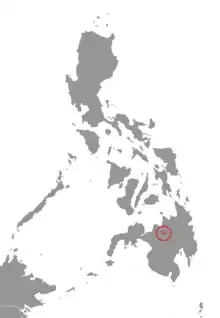| Katanglad shrew-mouse | |
|---|---|
| Scientific classification | |
| Domain: | Eukaryota |
| Kingdom: | Animalia |
| Phylum: | Chordata |
| Class: | Mammalia |
| Order: | Rodentia |
| Family: | Muridae |
| Genus: | Crunomys |
| Species: | C. suncoides |
| Binomial name | |
| Crunomys suncoides | |
 | |
The Katanglad shrew-mouse (Crunomys suncoides), also known as the Kitanglad shrew-mouse[4] is a species of rodent in the family Muridae.[5][6][7][8] It is known only from one specimen taken at 2250 m on Mount Kitanglad, Bukidnon Province, Philippines.[9]
Notes and references
- ↑ Kennerley, R. (2017) [errata version of 2016 assessment]. "Crunomys suncoides". IUCN Red List of Threatened Species. 2016: e.T29458A115168894. doi:10.2305/IUCN.UK.2016-3.RLTS.T29458A22448365.en. Retrieved 21 July 2018.
- ↑ Name – Crunomys suncoides Rickart, Heaney, Tabaranza & Balete 1998. ION: Index to Organism Names. Organismnames.com. Retrieved on 2012-12-28.
- ↑ Rickart, E. A. & Heaney, L. R. & Tabaranza, B. R. & Balete, D. S. (1998): A review of the genera Crunomys and Archboldomys (Rodentia: Muridae: Murinae), with descriptions of two new species from the Philippines. Fieldiana Zoology no. 89, pp. 1-24, 1998
- ↑ Heaney, L. & Tabaranza, B. (2008). Crunomys suncoides. In: IUCN 2012. IUCN Red List of Threatened Species. Version 2012.2.Downloaded on 28 December 2012.
- ↑ Musser, G.G.; Carleton, M.D. (2005). "Superfamily Muroidea". In Wilson, D.E.; Reeder, D.M (eds.). Mammal Species of the World: A Taxonomic and Geographic Reference (3rd ed.). Johns Hopkins University Press. pp. 894–1531. ISBN 978-0-8018-8221-0. OCLC 62265494.
- ↑ Kitanglad Shrew-mouse (Crunomys suncoides) – Information on Kitanglad Shrew-mouse – Encyclopedia of Life. Eol.org (2011-08-30). Retrieved on 2012-12-28.
- ↑ Name – Crunomys suncoides . ION: Index to Organism Names. Organismnames.com. Retrieved on 2012-12-28.
- ↑ Crunomys suncoides. Ubio.org (2006-04-13). Retrieved on 2012-12-28.
- ↑ Crunomys suncoides. fieldmuseum.org
The Katanglad shrew-mouse are mammals with small eyes, slender bodies, long whiskers, and chunky torsos. They prey on earthworms and soil invertebrates.[1]
Further reading
Wikimedia Commons has media related to Crunomys suncoides.
- Fur-mites of the family Atopomelidae (Acari: Astigmata) parasitic on Philippine mammals: systematics, phylogeny, and host-parasite relationships.
- bioone.org
- ncbi.nlm.nih.gov
- eol.org
- ↑ Balete. (2012). Archboldomys (Muridae: Murinae) Reconsidered: A New Genus and Three New Species of Shrew Mice from Luzon Island, Philippines. American Museum Novitates., 3754, 1–60.
This article is issued from Wikipedia. The text is licensed under Creative Commons - Attribution - Sharealike. Additional terms may apply for the media files.
